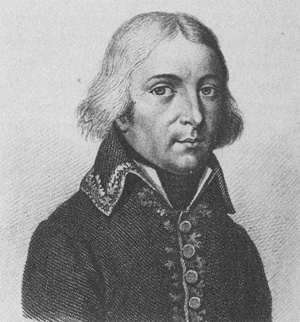General Elzéar Auguste Cousin de Dommartin

Born: May 26, 1768
Place of Birth: Dommartin-le-Franc, Haute-Marne, France
Died: July 9, 1799
Cause of Death: Illness
Place of Death: Rosetta, Egypt
Arc de Triomphe: DOMMARTIN on the south pillar
Pronunciation:
Embarking on his military career at age 16, Elzéar Auguste Cousin de Dommartin enrolled in the artillery school of Verdun in 1784. A year later he was a lieutenant in the regiment of artillery of Auxonne. His career was fairly uneventful until the French Revolution, when in 1792 he was promoted to capitaine in the 4th Foot Artillery. The next year, on September 2, 1793, Captain Dommartin was promoted to chef de bataillon of the 2nd Foot Artillery and he became the chief artillery officer for the soldiers moving to retake Toulon from the Royalists. Five days later on the 7th, Dommartin led an attack on Ollioules on the outskirts of Toulon and he was hit by a shot to the left shoulder. A promotion to chef de brigade came later that same day, and another promotion, this time to général de brigade, came on September 23rd. However, Dommartin was effectively out of action, enabling a young Captain Bonaparte in the vicinity to take command of the artillery at Toulon and make a name for himself.1
In 1795 Dommartin served with the Army of Italy, first in Sérurier's division and later Masséna's, and that year fought at Loano. At the end of the year he took command of the 3rd Brigade of Meynier's division, and then in March of 1796 he took command of the 1st Brigade. With General Bonaparte now leading the Army of Italy, Dommartin fought at Montenotte, Dego , and Mondovi . He briefly commanded the 2nd Brigade of Masséna's division, and then in May he took command of the Horse Artillery of the Army of Italy. In June Dommartin went with Vaubois to Livorno and then in August he commanded the light artillery during the fierce fighting at Castiglione . That September he fought at Roverdo and then in October he was made deputy commander of artillery of the Army of Italy. In 1797 Dommartin commanded the artillery sent to Romagne and then he distinguished himself at Tagliamento.
Dommartin kept busy during the relatively peaceful interlude before the campaign to Egypt. He commanded the artillery of the 17th military division for a month, then the 6th arrondissement of artillery for a few weeks before joining the army of the Sambre and Meuse, then the Army of the Rhine, and finally becoming inspector of artillery on the Mediterranean coast.
Named commander of the artillery of the Army of the Orient, General Dommartin accompanied the expedition, first seeing action at Alexandria. He participated in the Battle of the Pyramids and was promoted to général de division afterwards by General Bonaparte. He next served under Menou at Rosetta, and then in October he helped put down the revolt of Cairo. In 1799 he went on the expedition to Syria, directing the artillery at the sieges of El Arisch and Acre. Sent on a mission back to Rosetta, Dommartin returned to Cairo where he boarded a felucca named Nil. The next day, as they sailed down the river, a group of Arabs and Mamelukes attacked them. The French force was able to beat back the attack and escape, but Dommartin took two wounds that gave him tetanus. He made it to Rosetta on the 25th, but died within a few weeks due to the infection.
Notes
Bibliography
- Divry, Arnauld. Les Noms Gravés sur l'Arc de Triomphe. Paris: L'Harmattan, 2017.
- Haythornthwaite, Philip J. Who Was Who in the Napoleonic Wars. London: Arms & Armour, 1998.
- Six, Georges. Dictionnaire Biographique des Généraux & Amiraux Français de la Révolution et de l'Empire (1792-1814). 2 vols. Paris: Gaston Saffroy, 2003.
Updated March 2023
© Nathan D. Jensen